
Digital Summit Series Recap: The Changing Landscape of Technology and Digital Marketing11 min read
October 6, 2025Last week, I hit the road and headed down I-76 to Philadelphia for the Digital Summit Series. The event featured two full days packed with valuable digital marketing and technology insights from marketers, tech experts, and innovators sharing where things are heading in digital marketing and how technology is leading the way in impacting immediate and future change.
The sessions ranged from content marketing and social media strategy to martech audits, artificial intelligence (A), all things digital marketing, and the future of SEO. The advice went beyond theory, with actionable insights packaged and ready to apply. I returned home with a digital notebook (aka Google Docs) full of ideas.
As I was driving home with those ideas swirling around in my head, it hit me that they were too good to keep to myself. So, in the spirit of collaboration, I’m sharing them here on the Sharp Innovations blog to help you and your brand grow.
Here are six key takeaways that stood out, plus some thoughts on how they might shape the way we all approach digital marketing and strategy to round out 2025 and as we move into 2026 and beyond.
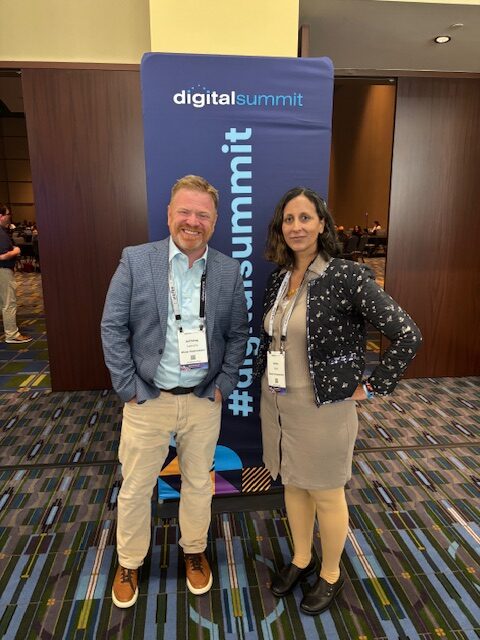
1. Social Media 3.0: Think Discovery First
One of the big themes was the changing face of digital marketing, and more specifically, social media. As search engines and social media algorithms change, the focus of your communication style should change as well. The idea is simple: create content for discovery, not just for your followers.
When you’re building your social media content, assume the person seeing it doesn’t know you. Lead with a strong hook that makes them stop scrolling. Spell out the problem you solve right away. That’s what draws people in.
Staying on-platform
Another big shift is how we package content. Instead of sending people off-platform with links, focus on self-contained posts. Give enough value in the content itself so someone can understand it without leaving LinkedIn, X, or Instagram. Platforms reward content that keeps people engaged right where they are.
Think about it. If you want someone to buy your product, would you promote content that sent them away from your product? No. That strategy doesn’t make sense for you, so why would it make sense for social media platforms?
So, if you want to add a link, I recommend adding it later on in the comments as the engagement begins to build.
Social media interest clusters
Meredith Howard, Senior Manager, Head of Global Global Digital Strategy and Activations at Deloitte, explored the concept of interest clusters during her day one session.
Howard defined interest clusters as being similar to content pillars on your website. Basically, a smaller, bite-sized version designed for social media.
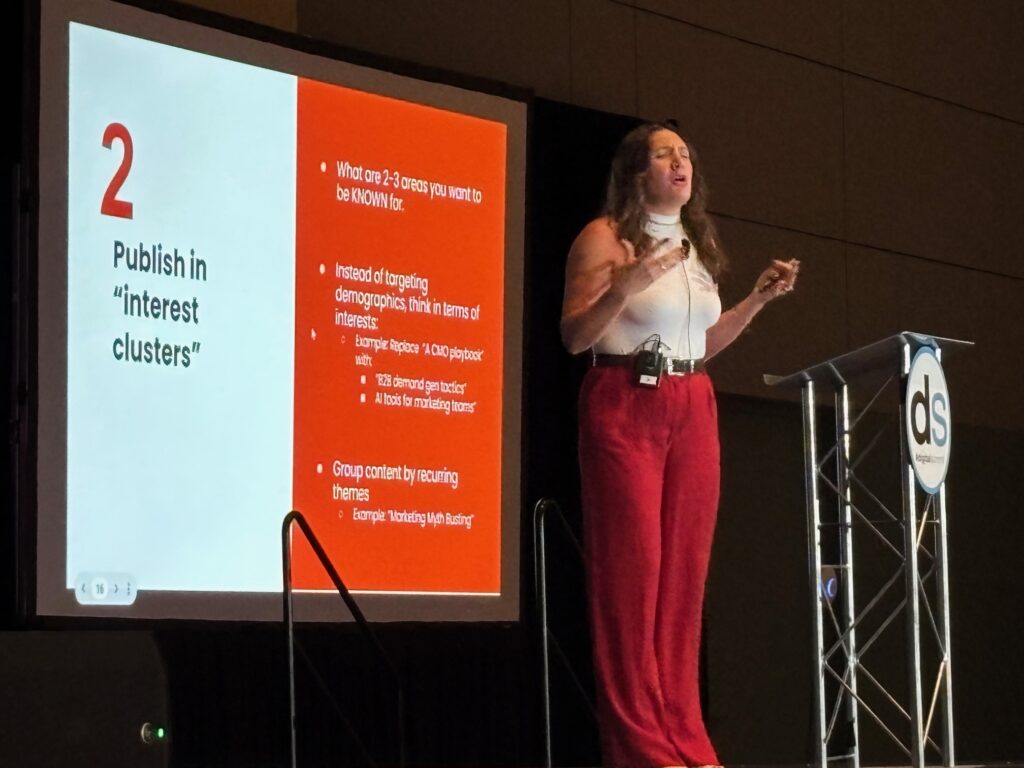
The key is to organize your posts around related, relevant topics that your audience cares about. This gives you more flexibility while still staying relevant.
Be trendy
And don’t forget about culture trends. If something’s blowing up online and it fits your brand, jump in quickly, ideally within 24 hours. If you’re late to the game, you’re wasting your time when it comes to trending topics.
It’s less about chasing every meme and more about showing you’re paying attention, so don’t go overboard here. Focus only on leveraging the trends that make sense for your brand.
2. Engagement Isn’t Just Posting
Another recurring theme across many of the sessions was that posting is only half the game. Commenting and engaging with other people’s content is just as important. Top brands understand this, and the do a great job of replying to posts from their target audience, influencers, and others in a conversational tone to drive awareness and join the conversation.
Where to reply
Find posts in your niche or “interest clusters” and add thoughtful comments. Use relevant keywords, join conversations, and be part of the community. This type of activity can increase visibility way beyond what your own feed might get.
One great example of this is Semrush. The search engine optimization (SEO) and content marketing SaaS brand’s team is highly active on social media. They regularly reply to followers’ posts, which helps to build trust and forge lasting relationships buy showing the team is listening.
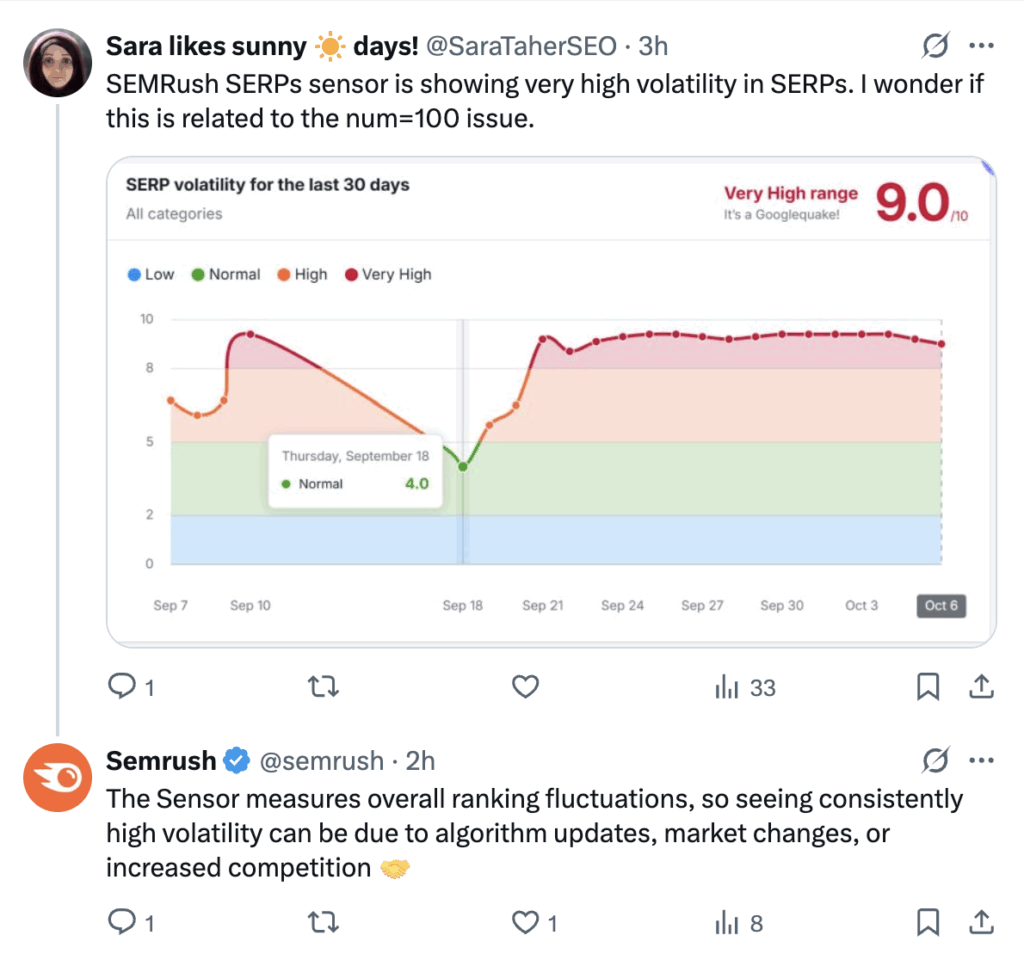
Bonus Tip: Use AI to figure out which of your posts are driving the most valuable engagement, not just likes. That way you know what’s worth doubling down on.
In the screenshots below, we uploaded a spreadsheet containing performance stats for a full year of LinkedIn posts and asked ChatGPT to provide us with insight into the top-performing content. This is high-level info, but we encourage you to dig deeper with more insightful, deeper-dive prompts.
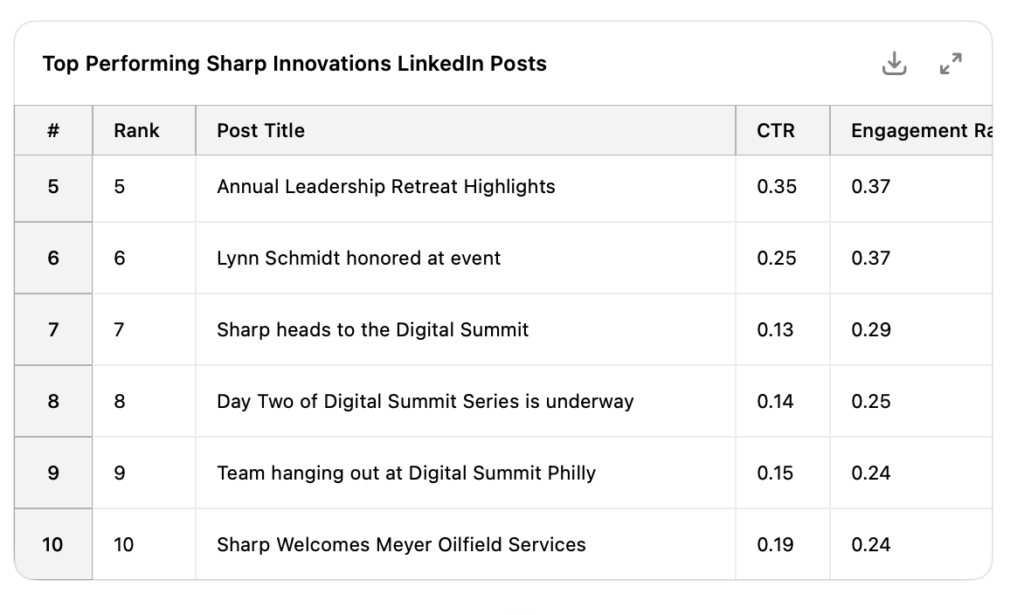
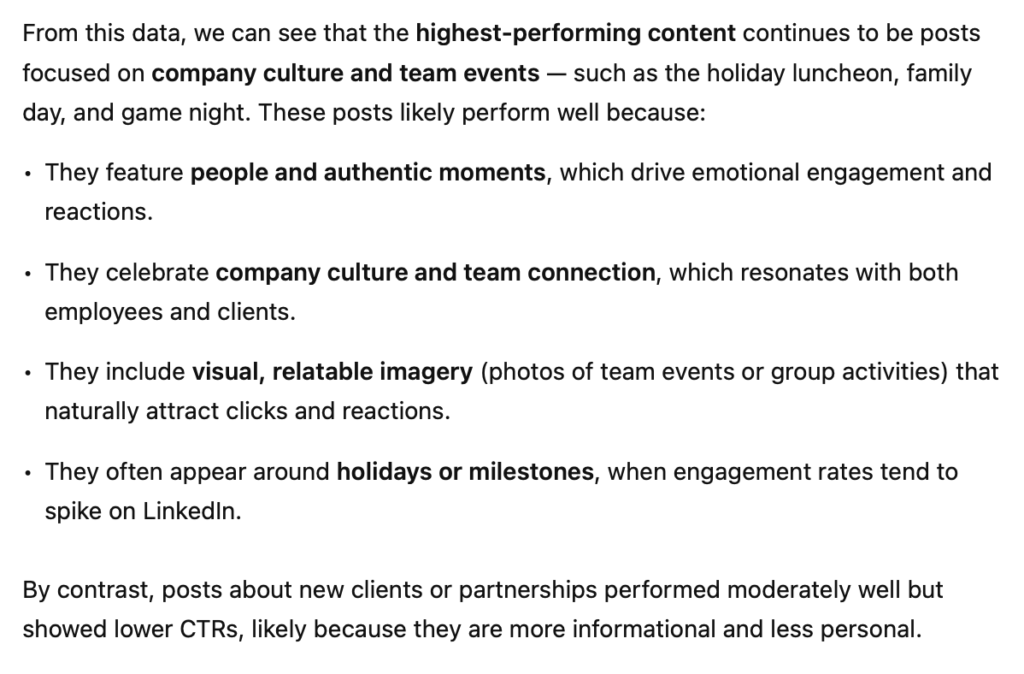
3. Martech: Streamline, Don’t Pile On
A lot of organizations struggle with Martech. Too many tools, not enough alignment. One session that stood out to me focused on building a content supply chain framework. Basically, creating an optimized path from idea to content delivery.
The path from idea to delivery is often a slow trek weighed down by bottlenecks. Many times, this is caused by too many tech tools and too little direction to the team for how to use them.
I sat in on a presentation on the topic of improving your martech stack by Ariana Keil, Senior Growth Marketing Manager at Canto.
During her presentation “Hack Your Martech Stack: Efficient Content Marketing with Innovative Tools and Optimized Creative Workflows,” Keil laid out several popular content marketing workflows and highlighted the key areas where bottlenecks occur.
The slides below are from Keil’s presentation and give you an idea of where issues can arise.
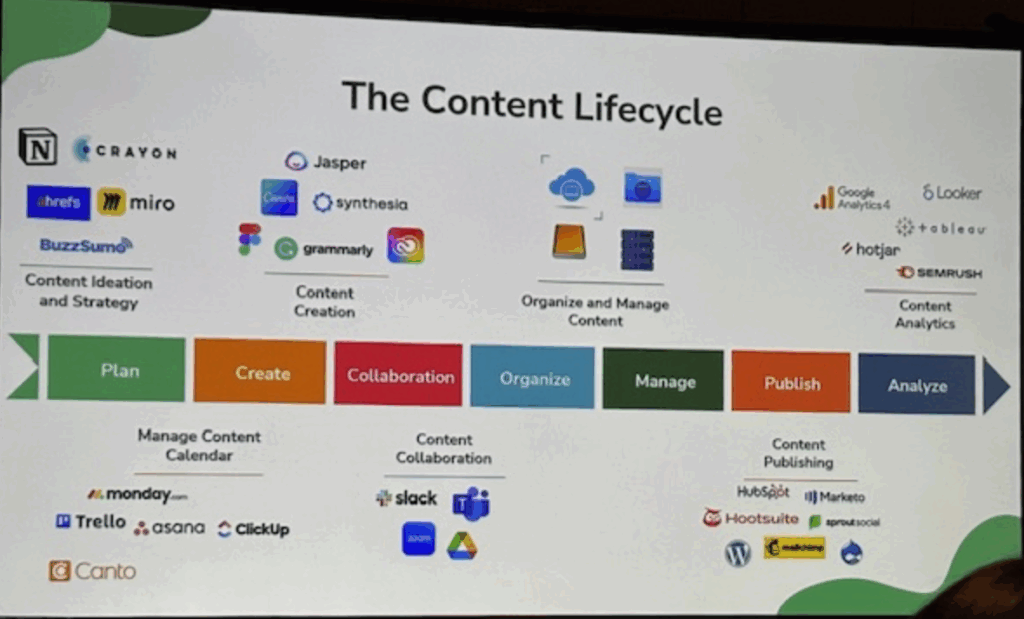
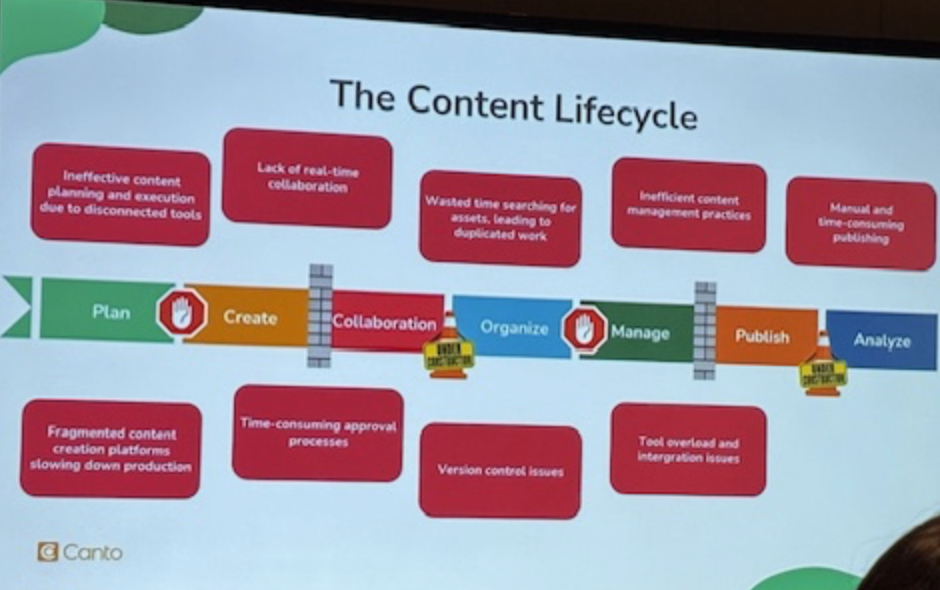
Keil warned that the framework is less about buying shiny new tools and more about removing inefficiencies. If five teams use five different tools to get content live, you’re wasting time and money.
How to get started
A practical first step is running a Martech audit. Write down every tool your team is using. Map out what it does, what stage of the customer journey it supports, and how it integrates with other tools. Then score it on ease of use, adoption, and ROI.
From there, you can consolidate, replace, or cut tools. The point is to build an ecosystem that works together, not a random pile of subscriptions.
AI can help here too. Think content ideation tools, automated content briefs, or even AI tagging for your DAM. But those gains only matter if the workflows and governance are in place first.
Suggested Reading: Integrating Systems: Making Platforms Work Together Smoothly (and the Role of AI)
4. Managing Content Assets: Don’t Let Files Disappear
This one hit close to home. Most companies don’t have a great system for storing or reusing digital assets. Content lives in random folders, on hard drives, or in cloud services with no structure. The result? Teams waste time recreating assets instead of reusing them.
At Sharp Innovations, we have some solid systems in place. Our own assets are well-organized, and each of our clients has a system set up so that our team (and their team) can easily access the right content, at the right time.
But I have seen the other side as well. It’s not pretty. I’ve helped many organizations clean up giant technological chaos. Thankfully, today we have new technologies available to help keep things in order and management workflows.
One presentation I enjoyed on this topic was Kelsey Fielding, VP of Client Success at MediaValet. She covered a range of topics, exploring how a well-organized DAM can make old content findable and how to set up your organization for success.
Modern DAM tools, like MediaValet, even bring in AI to auto-tag assets, connect them by theme, and surface them when you’re working on new projects.
It’s not just about storage. A DAM also keeps your assets on-brand, enforces usage rights, and maintains version control. And with AI, it can even help make sure new content aligns with your brand voice and values.
If content is one of your biggest investments, it makes sense to treat it like a long-term asset rather than one-off files that get lost in the shuffle. The right Digital Asset Management tool can help.
5. AI Everywhere: Start Small, Build Policy
No surprise here. AI was everywhere at the Digital Summit Series in Philadelphia. But instead of saying “AI will change everything,” speakers encouraged companies to start small. The role AI plays in your digital marketing will continue to expand, so get on board now or risk falling way behind.
This should come as music to the ears of many of you. You don’t have to be on every shiny, new AI platform that hits the market.
Pick one or two high-impact use cases, like AI-assisted content briefs or AI voiceovers for ads. Or maybe for your organization, it’s creating video ads. As one speaker noted, some teams saw 5–20% higher conversions using AI voices in video ads.
Assess your particular situation, and determine where AI would help the most. Focus on one or maybe a small handful of areas (depending on your resources, and build out slowly from there.
One important step you cannot afford to skip…
Create an AI policy.
Define what tools are allowed, how AI should be used, and how results are shared internally.
One idea I loved. Creating an “AI Wins” Slack channel where the team shares prompts, tools, and experiments. It helps everyone learn faster.
Encourage your team to create screengrab videos when they learn a new AI trick so they can share the walkthrough with the team. Build the excitement and the resources available to help ensure buy-in.
100% of the sessions I attended either sprinkled in an element of AI talk or they went all in, focusing fully on how AI impacts certain areas of our businesses.
The message was clear. AI isn’t about doing everything at once. It’s about focused experimentation, governance, and integration into the tools you already use.
6. SEO Meets AI Search
Let’s not ignore the elephant in the room. How AI is reshaping search is a hot topic everywhere you go as a marketing professional, and it was definitely a hot topic during the Digital Summit Series in Philadelphia.
Studies show Google’s AI Mode is already placing sidebar links in over 90% of results. And here’s the kicker, a lot of those citations aren’t from the usual top 10 websites.

That means SEO is shifting from being purely about page-level rankings to domain-level authority. If your site has multiple strong, well-structured pages on a topic, you’re more likely to get pulled into AI-generated answers.
Another insight that resonated with me was that community-driven platforms like Reddit and Quora are showing up a lot in AI search citations. It’s a sign that real conversations and user-generated content are getting more weight in these models.
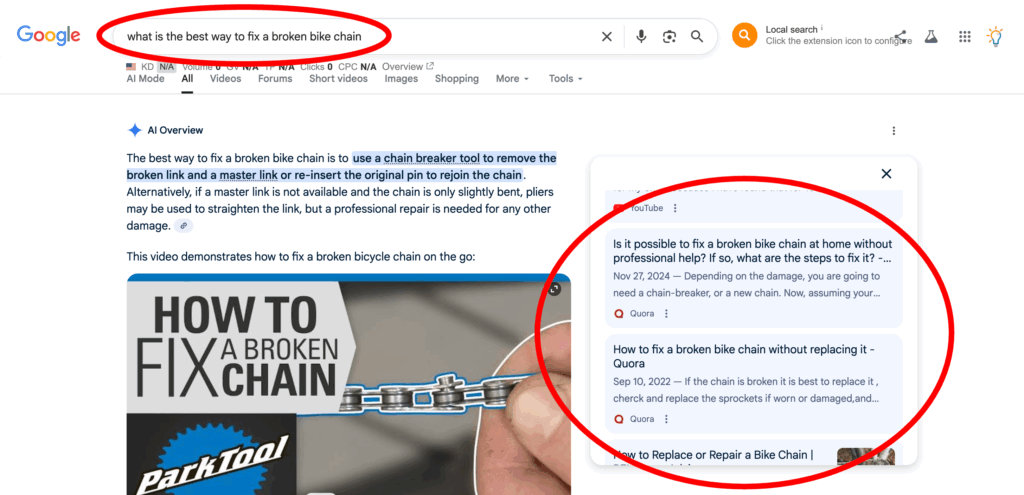
Here’s why this matters for marketers. Traffic from AI search may be worth more. Semrush found that AI-driven visitors convert at a higher rate because they’re often further along in the decision process.
So, is SEO “dead”?
Definitely not. But the rules are shifting fast. Think less about chasing keywords and more about building topical authority, domain strength, and a presence in community conversations.
A Common Thread in Digital Marketing
The Digital Summit Series in Philadelphia was a great chance to step back and see how all these trends connect. From the new face of social to Martech audits, AI, and search, the common thread is this.
Digital marketing in 2025 and beyond will reward clarity, structure, and smart experimentation.
You don’t need to adopt every new tool or trend tomorrow. Start small, focus on the areas where your team struggles most, and keep learning.
If there’s one thing this event reinforced, it’s that we’re all figuring this out together. And that’s exciting.
For more content and takeaways about the Sharp Innovation team’s experience at Digital Summit Series Philadelphia, follow us on social media on LinkedIn, X (formerly Twitter), and Facebook.

Anthony is Chief Marketing Officer (CMO) at Sharp Innovations. He is a two-time published author and award-winning marketing & brand strategist. He has helped brands both large and small grow and thrive across multiple industries through strategic marketing campaigns and leveraging a powerful network of influencers.